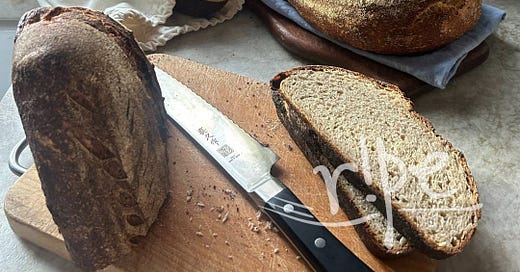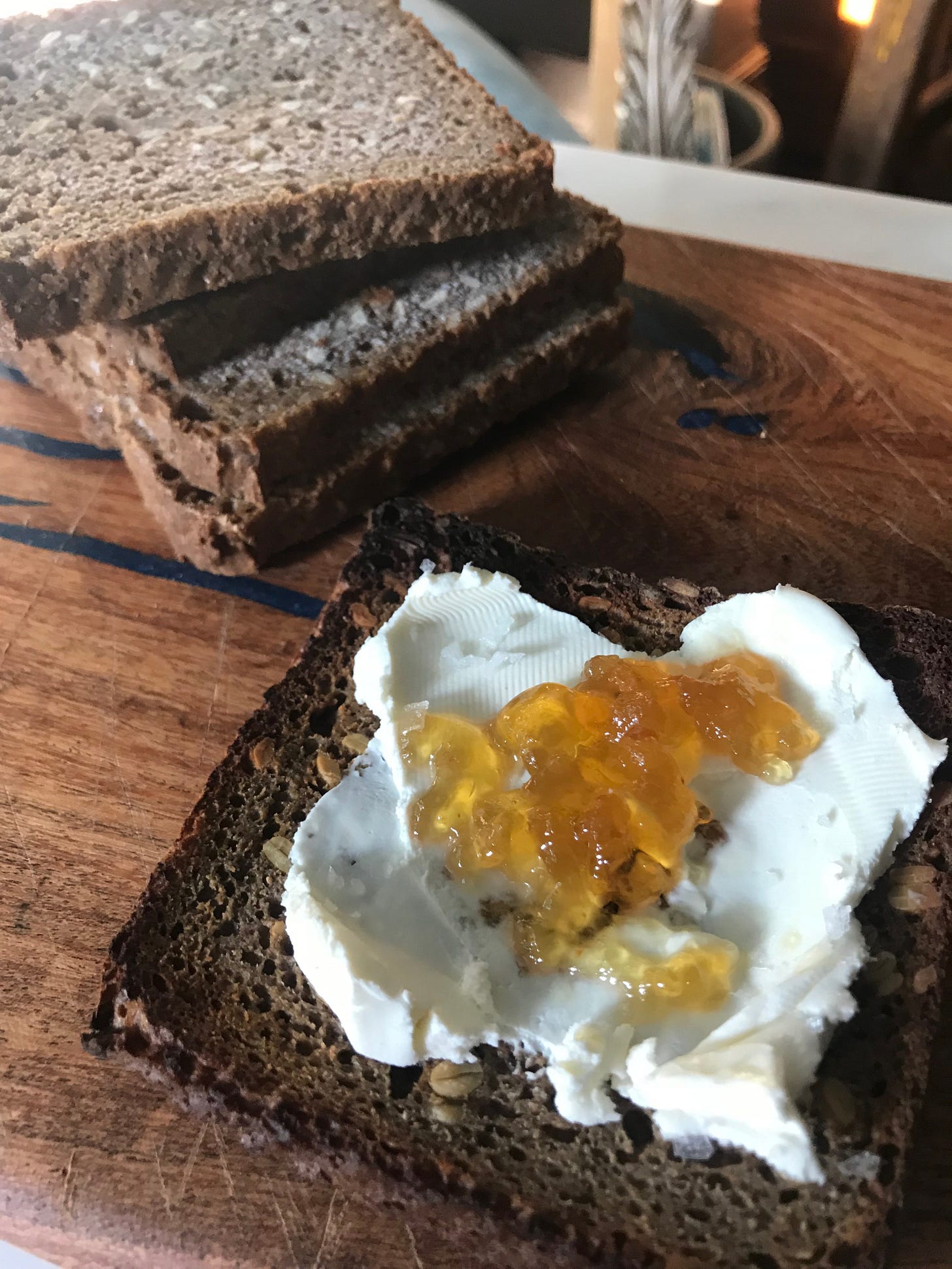Ten Years of Sourdough Baking
The Sourdough Library • Keeping a Starter and How to Save a Starter • Pullmans, Bâtards, Boules, Crackers, and Bagels
This past Saturday I sent my sourdough starter stats into the Puratos Sourdough Library in Belgium, step one of being involved with the project to understand and preserve sourdough biodiversity world-wide. Karl De Smedt, the curator of the sourdough library, got me pretty excited about the prospect.
Whether my starter gets included or not, I know it is teaming with good stuff because it gets bubbly and active within hours of feeding. The sourdough library wanted to know the birthday of my starter and I found it by going through my cooking journals: March 18, 2013.
Originally a 100%-rye starter, I now feed it with a 50/50 mix of stone-ground rye and ancient strains of wheat (spelt, Kamut, and others) milled by Judy Cornell of Conservation Grains. I keep two 25-pound buckets of her flour in my pantry at all times.
My baking rotation includes a dense European-style 100%-rye loaf (inspired by Marianne Wiener’s Anna’s Daughters’ Rye from Point Reyes Station back in the late 1990’s), a white Pullman loaf, and my current obsession, a free-form boule or bâtard made with 25–50% whole wheat (the remainder all-purpose, usually Wheat Montana, sometimes Highland Harmony Farm).
My website, Ripe, has my favorite sourdough recipes. I don’t share my rye recipe as I am toying with some business opportunities, but I do give away loaves every time I bake, so if you want a sourdough love present, just let me know!


How to Keep a Starter
When you first start keeping a starter it can seem a little intimidating, but really it is much more forgiving than the exacting measurements and timing make it out to be. I like using Weck jars (pictured is the 743, ¾ liter), it gives you plenty of room to stir, plenty of room to develop, and I like using the glass top (w/o the rubber gasket) so that some in-and-out air flow can happen. This is the jar Maurizio recommends, you may be familiar with his site, The Perfect Loaf, and if not, I highly recommend it as a resource. He’s a software engineer, so his recipes are very exacting, but I’ve found that once you get in a groove with your starter and what you like to bake, you can ease up a bit.
Keeping a Starter and How to Save a Sourdough Starter
So once you have a bit of starter, either from nurturing your own (I used this 9-day method from Girl Meets Rye, based on Tartine Bakery) or getting a blob from a friend who bakes, you need to keep it going. Ideally, I feed mine every week and keep it refrigerated. It can go two weeks but if it has been three or four, you’ll need to scrape off and discard the top liquid layer then scoop out a blob from lower down in the jar and get it into a new container, feed it, and move on. It’ll be ok unless the liquid layer was red or other bright colors, in which case toss the whole shebang and start over.
I like to have at least two of those Weck jars so that I can zero my scale with an empty one and then know how much starter I’ve got in my starter jar. When I feed, I keep 75 grams (discard/compost the overage) and feed it with 50 grams rye flour, 50 grams whole wheat flour, and 125 grams water (I use my tap water, it works fine).
When I want to bake, I need to get the starter revved up, feeding it from the fridge once every 12 hours or so about two or three times, depending on how fresh the starter is (e.g. has it been sitting in the fridge since last week’s feeding or did you just feed it and fridge it yesterday). Your starter is ready to bake when you can knock the jar of starter on the counter and the bubbles don’t collapse down. If your starter deflates easily when you do this, it isn’t ready for baking, so feed it again and wait until it is stronger. The starter must be on its way up versus on the decline so that its bubbly power can get in with the bread dough and do what its supposed to do (make the bread rise!)
About Sourdough Discard (and what you can make with it)
Every time you feed your starter, you save a small amount (I target 75 grams, but you can do less if you don’t need as much starter for baking), discard the rest, then add fresh flour to feed the reserve.
Wasting the discard takes a toll psychologically so find a few things you like to make with discard. That or compost. When I want bread, I want freshly baked sourdough not a bunch of pancakes and cookies made with discard, but I do like these crackers from Maurizio.
There is a learning curve with sourdough but in time your sense of things will develop and you can break free from rigid instructions. Andra Stefanescu’s Instagram videos (@sourdoughexplained) have helped me tremendously, so check them out and relax into the process. Another great Instagram for learning how to bake sourdough is Beautiful Living Made Easy, her no-knead sourdough is where I learned to use a cold ferment to make scoring easier and to facilitate a first-thing-in-the-morning bake. I hope you find these resources helpful! It does get easier and more fun. Along the way, do know that even a “bad” sourdough tastes great toasted with butter and you can always make croutons.
Bye for now. Happy baking!











Do you ever ship your bread if I pay for shipping etc?